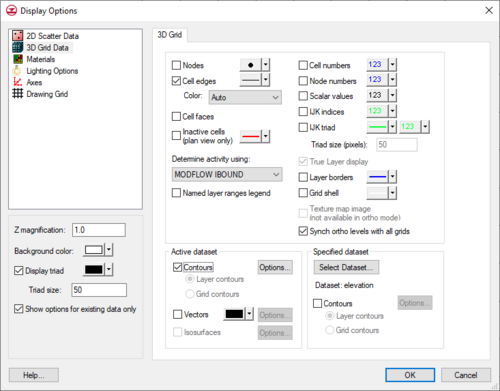GMS:3D Grid Display Options
The properties of all 3D grid data that GMS displays on the screen can be controlled through the 3D Grid tab of the Display Options dialog. This dialog is opened by right-clicking on the 3D Grid Data ![]() entry in the Project Explorer and selecting the Display Options command. It can also be accessed from the from the Display menu or the Display Options
entry in the Project Explorer and selecting the Display Options command. It can also be accessed from the from the Display menu or the Display Options ![]() macro. The following table describes the display options available for the 3D Grid module.
macro. The following table describes the display options available for the 3D Grid module.
| Display Option | Description |
|---|---|
| Nodes | Displays grid node dots on the cell corners for both cell-centered and mesh-centered Grid Types. Node display can be adjusted in the Point Properties dialog accessed through the point icon next to Nodes. |
| Cell edges | Displays the edges of grid cells. The cells are either drawn using the default cell color or the color of the material associated with each cell.
In addition to turning the display of cells on or off, GMS can temporarily hide grid cells. The color of the cell edges can be adjusted according to the following options:
|
| Cell faces | Causes the faces of the grid cells to be drawn as filled polygons. They are filled with the material color. |
| Inactive cells | Displays cells which are inactive. Inactive cells must be displayed before they can be selected. If inactive cells are not displaying after this option has been selected, make sure the ortho view is turned on. It is turned on by selecting the |
| Determine activity using | Sets the criteria for determining which cells to display as active or inactive.
Options for determining cell activity displays include:
|
| Named layer ranges legend | A legend showing the material and named layer ranges can be turned on. |
| Cell numbers | Displays the ID of each grid cell. |
| Node numbers | Displays the ID of each grid node. |
| Scalar values | Displays the scalar values of the active dataset for each node next to the node. |
| IJK indices | Displays the ijk indices of each cell or node. |
| IJK triad | Displays a symbol at one of the corners of the grid showing the orientation of the ijk axes. |
| True layer display | Displays vertical variations in stratigraphy as defined by the Top Elevation and Bottom Elevation arrays in MODFLOW. In Ortho Mode, the variations in stratigraphy are visible from the side views. In general mode, the variations are visible from any angle besides Plan View. The display of variations in stratigraphy will vary between general mode and ortho mode. True layer display enables the display of the Water table feature in MODFLOW. |
| Layer borders | Displays a solid line around the perimeter of the grid layers. |
| Grid shell | Displays a solid cube around the extents of the grid. Displaying the boundary is useful when isosurfaces are being displayed with the cell edges turned off. |
| Texture map image | Used to "drape" an image over the surface of the 3D Grid. |
| Synch ortho levels with all grids | When using MODFLOW-LGR with parent and child grids, GMS will find and display the appropriate level for all grids when the level of the active grid changes. Otherwise only the active grid level will change. |
| Contours | Most of the objects supported by GMS can be contoured by turning on the Contour Options in the Display Options dialog. When an object is contoured, the values associated with the active dataset for the object are used to generate the contours.
In the 3D Grid display options tab, use the Layer contours option to display on the surfaces of grid layers. Use the Grid contours option for the contours to display not only on the horizontal surfaces but along the vertical sides of the grid elements as well. |
| Vectors | If the Vectors item in the Display Options dialog is selected for an object (TIN, Grid, or Mesh), vector plots can be generated using the active vector dataset for the object. One vector is placed at each node, cell, or vertex. |
| Isosurfaces | If the Isosurfaces item in the Display Options dialog is selected for an object (3D grid or 3D mesh), isosurfaces will be generated. An isosurface is the 3D equivalent of a contour line. While a contour line is a line of constant value extracted from a surface, an isosurface is a surface of constant value extracted from a 3D dataset. |
| Specified Dataset | Allows displaying the contours of a second dataset that is specified by the user. Use the Select Dataset command to open a Select Dataset dialog and choose the dataset desired for display. Separate contouring options can be set for the active and the specified datasets. |
| [hide] GMS – Groundwater Modeling System | ||
|---|---|---|
| Modules: | 2D Grid • 2D Mesh • 2D Scatter Point • 3D Grid • 3D Mesh • 3D Scatter Point • Boreholes • GIS • Map • Solid • TINs • UGrids | |
| Models: | FEFLOW • FEMWATER • HydroGeoSphere • MODAEM • MODFLOW • MODPATH • mod-PATH3DU • MT3DMS • MT3D-USGS • PEST • PHT3D • RT3D • SEAM3D • SEAWAT • SEEP2D • T-PROGS • ZONEBUDGET | |
| Aquaveo | ||
